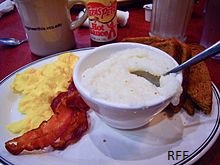What Are Grits? And How to Make Grits

Grits is a cornmeal porridge formed by boiling. Hominy grits are grits prepared from hominy, which is corn that has had the pericarp (ovary wall) removed and has been treated with an alkali in a process called nixtamalization. Grits are frequently served as a breakfast dish with a variety of flavorings. Grits can be savory or sweet, but savory spices are more popular. The meal originated in the South but is now accessible throughout the United States. Grits are frequently served as part of a supper entrée, such as shrimp and grits, which is popular in the South.
Grits are related to polenta and mielie pap, two thick maize-based porridges from around the world. Cooked grits are referred to as “hominy” in the Charleston area, whereas uncooked grits are referred to as “grist.” Grits come from the Old English word great, which means “coarse meal.”

Origin
The meal was created by the Muscogee tribe of Native Americans, who used corn that was similar to hominy. Native Americans taught American colonists how to create the meal, and it quickly became a national favorite.
A stone mill was used to grind the hominy into grits during the time. The ground hominy was then sorted, with the finer material being used as grit meal and the coarser being used as grits.
Three-quarters of all grits sold in the United States are purchased in the South, in a region known as the “grits belt” that stretches from Lower Texas to Washington, D.C. In 2002, Georgia declared grits to be the state’s official prepared dish. In South Carolina, a bill was sponsored to make it the official state food, but it died in committee. Despite this, South Carolina has a separate chapter of legislation dedicated solely to cornmeal and grits. In South Carolina, state law mandates the enrichment of grits and rice meals, comparable to the requirement for flour.
Depending on the color of the corn utilized, grits might be yellow or white. “Quick” grits, which have had the germ and hull removed, are the most common variety seen in supermarkets. “Speckled” grits are made up of whole kernel grits.
How to Make Cheese Grits Recipe?
Grits are made by whisking together water or milk and cornmeal over low heat. Whole grain grits take a lot longer to soften than “quick grits.”
Some people like their grits sweetened, while others dislike them. They’re frequently accompanied by butter. Grated cheese, sausage, bacon, salt, and pepper, or red-eye gravy are all options.
Leftover grits can be sliced and fried plain or with a breading to make “fried grits,” “fried hominy,” or “grit cakes.”
Dishes
Grits go well with a number of dishes, including eggs and bacon, fried catfish, shrimp, salmon croquettes, and country ham.
Shrimp and grits are a popular coastal dish in the Lowcountry of South Carolina and the Lower Coastal Plain of Georgia. While shrimp and grits originated in the South Carolina Lowcountry, particularly among the Gullah people, most people’s shrimp and grits dishes date back to the Crooks Corner restaurant in Chapel Hill, North Carolina, in 1982.
Cooked grits that have solidified can be sliced and fried in vegetable oil, butter, or bacon grease, or they can be coated in beaten egg and bread crumbs first.



